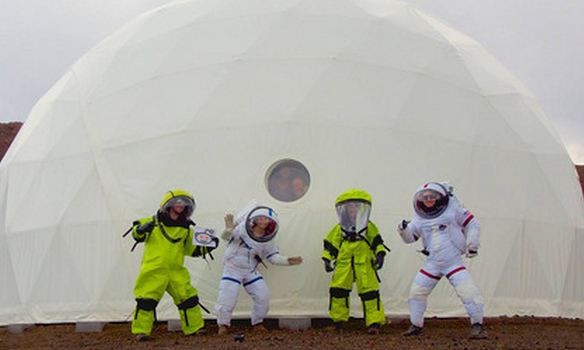Volunteer Astronauts Leave Replica Mars Base after Four Months' "Imprisonment"
| Arthur Dominic Villasanta | | Jul 27, 2014 09:57 AM EDT |
What's it like spending four months cooped-up inside a pseudo "Mars Base" cut-off from the rest of the world?
Each of the six volunteers that were part of the second "Hawaii Space Exploration Analog & Simulation" mission or HI-SEAS 2 had their own opinions but most of them said it was being deprived of the everyday things they take for granted that affected them the most.
Like Us on Facebook
Things like a refreshing wind and a drenching rain.
"I haven't seen a tree, smelled the rain, heard a bird, or felt wind on my skin in four months," said mission commander Casey Stedman, an officer in the U.S. Air Force Reserve.
HI-SEAS 2 was a "Mars analog habitat" designed to simulate the physical and psychological environment of a Martian exploration mission. Mars analog habitats prepare astronauts, engineers, and researchers for the future challenges of traveling to and living on Mars.
Stedman and five other volunteers spent four months "imprisoned" inside a replica Mars base atop the active Mauna Loa volcano in Hawaii, 8,000 feet above sea level.
Beginning late March, the HI-SEAS 2 crew lived and worked in a cramped, two-story, 11 meters wide, solar-powered dome on the slopes of Mauna Loa on the Big Island of Hawaii.
The team only left their Mars Base during simulated "Marswalks." They wore replica spacesuits to explore the "Marslike" environment of the tortured landscape of Mauna Loa.
They conducted a series of personal research projects during the pseudo Mars mission.
The crew's base included a kitchen stocked with non-perishable, freeze-dried food they cooked for their meals.
The three women and three men exercised at least an hour each day and spent their leisure hours playing board games, reading and interacting on social media, among others.
Apart from Stedman, the other members of HI-SEAS 2 were Physics Ph.D. student Ross Lockwood; spaceflight research assistant Tiffany Swarmer; space-engineering Ph.D. candidate Lucie Poulet; NASA scientist Anne Caraccio and neuropsychologist Ronald William.
After leaving their mock Mars habitat on July 25, the crew webcast their "return to Earth" live on a Google Hangout.
They're now looking forward to returning to normal life, and experiencing all the things they've missed on their four-month-long stay on "Mars."
The mission was run by the University of Hawaii at Manoa and funded by NASA's Human Research Program.
©2015 Chinatopix All rights reserved. Do not reproduce without permission
EDITOR'S PICKS
-

Did the Trump administration just announce plans for a trade war with ‘hostile’ China and Russia?
-

US Senate passes Taiwan travel bill slammed by China
-

As Yan Sihong’s family grieves, here are other Chinese students who went missing abroad. Some have never been found
-

Beijing blasts Western critics who ‘smear China’ with the term sharp power
-

China Envoy Seeks to Defuse Tensions With U.S. as a Trade War Brews
-

Singapore's Deputy PM Provides Bitcoin Vote of Confidence Amid China's Blanket Bans
-

China warns investors over risks in overseas virtual currency trading
-

Chinese government most trustworthy: survey
-

Kashima Antlers On Course For Back-To-Back Titles
MOST POPULAR
LATEST NEWS
Zhou Yongkang: China's Former Security Chief Sentenced to Life in Prison

China's former Chief of the Ministry of Public Security, Zhou Yongkang, has been given a life sentence after he was found guilty of abusing his office, bribery and deliberately ... Full Article
TRENDING STORY

China Pork Prices Expected to Stabilize As The Supplies Recover

Elephone P9000 Smartphone is now on Sale on Amazon India

There's a Big Chance Cliffhangers Won't Still Be Resolved When Grey's Anatomy Season 13 Returns

Supreme Court Ruled on Samsung vs Apple Dispute for Patent Infringement

Microsoft Surface Pro 5 Rumors and Release Date: What is the Latest?










